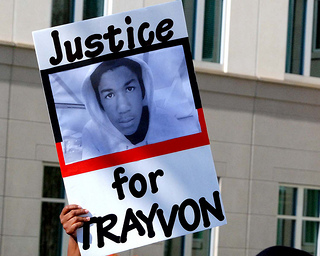How A Florida Law Makes Trayvon Martin’s Death “Reasonable”

On the 26 of February, a rainy night in Sanford, Florida, Trayvon Martin was walking through his neighborhood to get home to his father after buying Skittles candy at a nearby bodega. As he idly strolled through the suburban sidewalks of his small Twin Lakes community, he quickly found himself being stalked by a 28 year-old man by the name of George Zimmerman.
Zimmerman deemed this black 17 year-old teenager as a threat and called the local police department to investigate. But, before long, the two of them were scuffling together — in front of the home windows of local residents — until Zimmerman eventually revealed his Kel Tek 9mm handgun from his waistband and shot Martin. Though Martin’s family already buried Trayvon on March 12, they — along with the rest of the nation — continue to mourn over this irreversible tragedy that cannot bring itself to closure with a death being left unjustified.
But according to police, with Zimmerman merely perceiving Martin as a threat, his shooting is exempt of any first-degree murder charges. Back in 2005, a Florida state law colloquially known as “stand your ground,” was passed by legislation allowing people to use deadly force – where such force has long been allowed – if they have reasonable fear an assailant could seriously harm them or someone else. However, what is considered reasonable makes the law fluid, and open to a case-by-case interpretation. Even the author of the law, State Representative Dennis K. Baxley, has stated that his law doesn’t apply to Trayvon Martin’s case.
Regardless, the only thing that matters is Sanford Police Chief Bill Lee has decidedly marked Zimmerman’s baseless profiling of Trayvon “reasonable” — in spite of Zimmerman’s persistence to follow Trayvon even after 911 operators asked him to not follow him. It remains a “reasonable” murder, in spite of Zimmerman’s hazy eight year history as a neighborhood watch vigil with 46 police reports of him calling the police based off suspicions of mostly African American suspects. It remains a “reasonable” murder, in spite of 911 reports alleging Zimmerman sounded intoxicated during the call while the police who arrived at the scene failed to screen a mandatory test to see if Zimmerman was in fact intoxicated. And it remains a “reasonable” murder, in spite of multiple neighborhood witnesses even claiming they heard Trayvon calling out for help.
It’s now a federal case; what has been officially relegated as a case of self-defense by the local police reports is being interpreted as a case of racial profiling by swaying opinions across the country. This case that has brought national attention, has resurfaced the infamous Emmett Till case back in 1955; when Till, a black 14-year-old from Chicago visiting relatives, was reportedly flirting with a white girl that eventually instigated his gruesome murder by a couple Mississippi residents who were later acquitted. What was a much more harrowing and senseless crime that feels like an eternity ago, has stimulated national inquiry on just how differently we stand from that event a few civil rights laws and a Malcolm X later.
Paul Adams is a writer who lives in Los Angeles, follow him on Twitter @Yustomovic.
[Photo By werthmedia]

